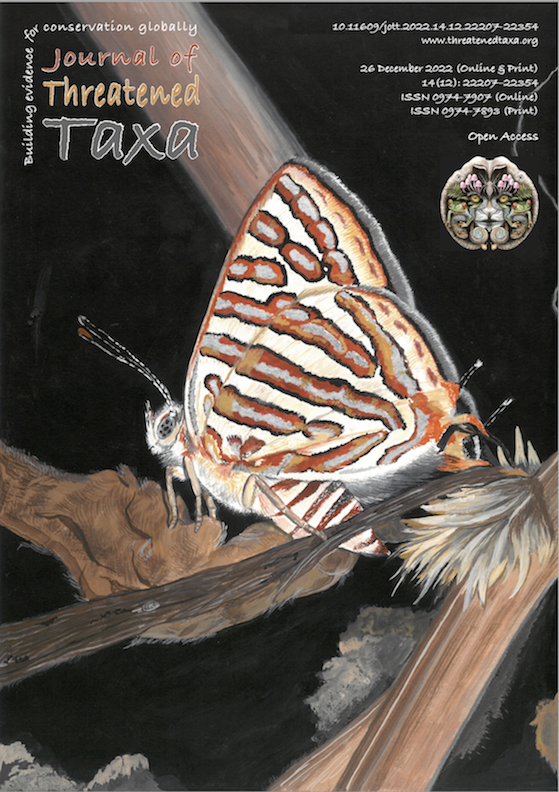A preliminary survey of moss flora of Chail Wildlife Sanctuary, Himachal Pradesh, India
Main Article Content
Abstract
The present study aims to account for the moss flora of Chail Wildlife Sanctuary, district Solan, Himachal Pradesh (HP). Frequent field visits were made in different seasons to collect moss samples. Ecological data like temperature, humidity, and habitat preferences were also recorded at the time of collection. A total of 31 moss species belonging to 22 genera and 15 families were recorded so far. The family Pottiaceae (7 spp.) was the most dominant one, followed by Brachytheciaceae (4 spp.), Polytrichaceae, Fissidentaceae, and Entodontaceae with (3 spp.) each. In the acrocarpous mosses, family Pottiaceae was highly dominant, whereas, among the pleurocarpous mosses family, Brachytheciaceae was dominant. Among the genera, Atrichum P. Beauv. (Acrocarpous), Fissidens Hedw. (Acrocarpous), and Entodon C. Muell. (Pluerocarpous) were dominantly present, represented by three species each. This study provides baseline data of moss diversity and their ecological attributes in Chail Wildlife Sanctuary, which may prove beneficial in establishing policies for future exploration of bryodiversity with proper management and conservation in the sanctuary area.
Article Details

This work is licensed under a Creative Commons Attribution 4.0 International License.
Authors own the copyright to the articles published in JoTT. This is indicated explicitly in each publication. The authors grant permission to the publisher Wildlife Information Liaison Development (WILD) Society to publish the article in the Journal of Threatened Taxa. The authors recognize WILD as the original publisher, and to sell hard copies of the Journal and article to any buyer. JoTT is registered under the Creative Commons Attribution 4.0 International License (CC BY), which allows authors to retain copyright ownership. Under this license the authors allow anyone to download, cite, use the data, modify, reprint, copy and distribute provided the authors and source of publication are credited through appropriate citations (e.g., Son et al. (2016). Bats (Mammalia: Chiroptera) of the southeastern Truong Son Mountains, Quang Ngai Province, Vietnam. Journal of Threatened Taxa 8(7): 8953–8969. https://doi.org/10.11609/jott.2785.8.7.8953-8969). Users of the data do not require specific permission from the authors or the publisher.
References
Alam, A. (2013). Moss flora of western Himalayas, India-An updated Checklist. Archive of Bryology 168: 1–28.
Alam, A., V. Sharma, S.C. Sharma & S. Yadav (2013). Hypnum plumaeforme Wilson-New addition to the Bryoflora of western Himalayas, India. Archive for Bryology 170: 1–4.
Asthana A.K. & V. Sahu (2013). Bryophyte Diversity in Mukteshwar (Uttarakhand) : an overview. Archive for Bryology 154: 1–11.
Bahuguna, Y.M., S. Gairola, P.L. Uniyal & A.B. Bhatt (2016). Moss flora of Kedarnath Wildlife Sanctuary (KWLS), Garhwal Himalaya, India. Proceedings of the National Academy of Sciences, India Section B: Biological Sciences 86(4): 931-–943.
Bryophytes in India - ENVIS Resource Partner on Biodiversity. http://www.bsienvis.nic.in/Database/Bryophytes. Accessed on 07 February 2022
Chopra, R.S. (1975). Taxonomy of Indian Mosses (An Introduction). In botanical monograph number 10. Publications and information directorate (CSIR), New Delhi, India, 599 pp.
Chopra, R.S. & S.S. Kumar (1981). Mosses of the western Himalaya. AnnalesCryptogamici et phytopathologici, vol 5. The Chronica Botanica Company. New Delhi, India, 142 pp.
Gangulee, H.C. (1969–1980). Mosses of Eastern India and Adjacent Regions. Vol. 1–III, Books and Allied Limited, Calcutta, 2145 pp.
Goffinet, B. & W.R. Buck (2004). Systematics of the Bryophyta (mosses): from molecules to a revised classification. Molecular systematics of bryophytes. Monographs in Systematic Botany 98: 205–239.
Ismail, Z., A.A. Khuroo, M.Y. Bhat, S. Rasheed, R. Ahmad & G.H. Dar (2020). An Updated Checklist of Bryophytes in Jammu and Kashmir State. In: Dar, G. & A. Khuroo (eds.). Biodiversity of the Himalaya: Jammu and Kashmir State. Topics in Biodiversity and Conservation, vol 18. Springer, Singapore. https://doi.org/10.1007/978-981-32-9174-4_16
Joshi, P.K., S. Singh, S. Agarwal & P.S. Roy (2001). Forest cover assessment in western Himalaya, Himachal Pradesh using IRS 1C/1D WiFS data. Current Science 80(8): 941–947.
Kapila, S. & S.S. Kumar (2003). Cytological observations on some West Himalayan mosses. Cryptogamie Bryologie 24(3): 271–275.
Kumar, S. & D.K. Singh (2002). Contribution to the Mosses of Gobind National Park, Uttaranchal, India. Nelumbo 44(1–4): 119–134.
Kumar, S.S. (1980). Taxonomic studies in West Himalayan mosses-1. Hikobia 8: 245–258.
Nath, V., A.K. Asthana & V. Sahu (2008). Addition of three moss species to West Himalayan Bryoflora. Cryptogamie Bryologie 29(4): 387–392.
Riaz, M., A. Sharma & A. Langer (2015). A preliminary study on the moss flora of Kishtwar, J&K (North-West Himalaya). Journal of Plant Development Sciences 7(10): 737–742.
Sahu, V. & A.K. Asthana (2014). Two mosses new to West Himalayan Bryoflora. Proceedings of the National Academy of Sciences, India Section B: Biological Sciences 84(3): 805–810.
Sahu, V. & A.K. Asthana (2015). Diversity in Mosses of Pithoragarh and its Neighbouring Areas, Western Himalaya, India. Indian Forester 141(11): 1183–1193.
Sahu, V. & A. Asthana (2012). Two Mosses New to West Himalayan Bryoflora. Phytotaxonomy 12: 63-67. https://doi.org/10.1007/s40011-013-0290-7
Saxena, D.K., S. Kumar & S. Saxena (2014). First report of the moss Rhynchostegiella divaricatifolia (Renauld & Cardot) Broth. from western Himalayan region of India. Phytotaxa 8(1): 59–64.
Saxena, D.K., S. Singh & K. Srivastava (2006). Distribution of some mosses in Nainital, Almora and Pithoragarh district of Kumaon region, India. Environment Conservation Journal 7(1–2): 83–87.
Sharma, S.K. & R.R. Choyal (2011). Distribution of moss in the topography of Kangra district (HP). Indian Journal of Fundamental and Applied Life Science 12: 54–156.
Tewari, S.D. & G. Pant (1994). Bryophytes of Kumaon Himalaya. Bishen Singh Mahendra Pal Singh, Dehradun, (Reprint 2002), 240 pp.
Vohra, J.N. (1983). Hypnobryales Suborder Leskeineae (Musci) of the Himalayas. Botanical Survey of India, Howrah, India, 366 pp.

